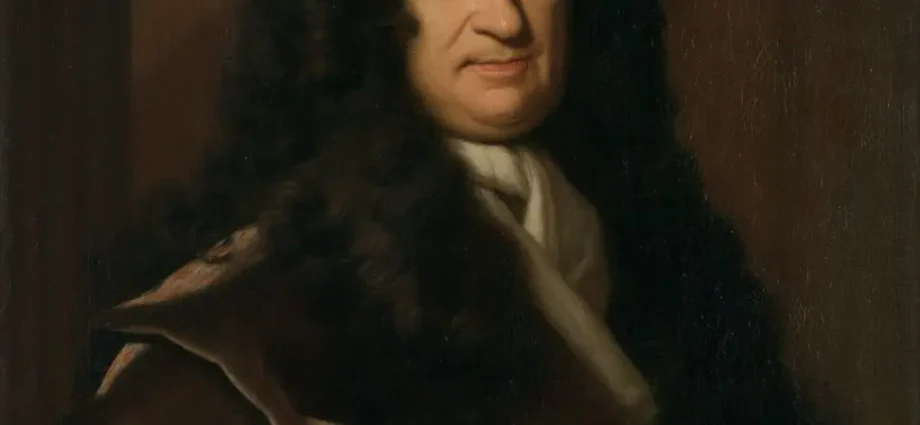😉 Greetings to regular and new readers! In the article “Leibniz: biography of a German scientist, facts” about the life of Gottfried Wilhelm Leibniz – a philosopher, mathematician, physicist, historian, diplomat, lawyer and inventor. Lived: 1646-1716.
Gottfried Wilhelm Leibniz: biography
Leibniz’s father was a professor of philosophy at the University of Leipzig, he died when the boy was seven years old. Even before school, Gottfried voraciously read everything that fell into his hands in the large home library. Even the fact that many books were written in Latin, unknown to him, did not stop him.
Reading the captions under the drawings and comparing the texts with the content of the drawings, the boy independently mastered the Latin language. He spoke and wrote Latin poetry fluently. Soon he easily mastered the ancient Greek language.
In his senior year at school, the thirteen-year-old Gottfried was deeply impressed by logic. He was struck by the fact that an infinite variety of statements can be classified using a small number of logical forms.
He forms the opinion that logic can cover all areas of human knowledge, create rules of thinking, and become a universal means of knowing the truth.
Philosophy of Leibniz
After leaving school, he becomes a student at the University of Leipzig. There he studies philosophy, jurisprudence and elementary sections of mathematics. He gets acquainted with the philosophy of Descartes and, in order to perfectly master it, begins to study mathematics.
Since there were no well-known mathematicians at the University of Leipzig, Leibniz studied at the University of Jena, and attended the lectures of Professor Weigel.
Back in Leipzig, Gottfried prepares to become a lawyer. Acquires a master’s degree in philosophy, a bachelor’s degree in law. In 1666, in the town of Altdorf, he brilliantly defended his thesis for the degree of Doctor of Law. He was immediately offered the position of professor, but he did not accept this offer and left for Nuremberg.
In 1666, the scientist publishes the treatise “Discourse on Combinatorial Art”. For the first time, he sets out the contours of his grandiose plan – the creation of a “general characteristic”, an “alphabet of human thoughts”, a universal logical speech.
In it, a system of precisely established signs denotes concepts and elementary statements. Formulas are used for logical reasoning, and chains of statements are equations.
Thus, any reasoning is formalized. From them, with the help of strictly defined rules (operations) over the introduced symbols of reasoning, new correct statements can be obtained.
So, you can analyze and deduce new dependencies, new laws in any deductive theory. The general characteristic was to become a comprehensive algebra applied to different kinds of knowledge.
Hence the famous aphorism: “Let’s not argue, but calculate the truth.” It was the idea of the mathematization of all science and the logic of mathematics, which embodied the first cybernetic dreams.

House of Leibniz (Hanover). Here he lived from 1698 until his death on November 14, 1716.
They were very ahead of their time and were not truly appreciated by contemporaries, but they became decisive in all the multifaceted activities of the scientist. This greatly contributed to the success in his scientific research.
Leibniz: scientific activity
Soon Leibniz’s life takes a sharp turn. He becomes a lawyer and adviser to the elector and after a while, on his instructions, leaves for Paris. There he met scientists, including the famous Christian Huygens.
To understand the book “Pendulum Clock” donated by Huygens, Leibniz, as he himself wrote, “went” into the works of Descartes, Fermat, Wallis, Pascal.
In 1673, Leibniz created a mechanical calculator (adding machine) that performs addition, subtraction, multiplication and division of numbers, as well as extraction of roots and exponentiation.
Thanks to the scientist, the Academy of Sciences was established in Berlin in 1700. Gottfried Wilhelm Leibniz became the first president of the Academy.
Notable students of Leibniz: Jacob Bernoulli, Johann Bernoulli, Christian von Wolf. An interesting fact is that the scientist was friends with Tsar Peter I.
The greatest scientist died in 1716, at the age of 70. His zodiac sign is Cancer. For Germany, Leibniz was what Plato, Aristotle, and Archimedes were to Ancient Greece.
Two types of problems became basic for mathematicians of the XNUMXth century:
- Calculation of areas, volumes and centers of gravity of figures.
- Drawing a tangent to a curved line.
Scientists of Ancient Greece were still engaged in this, but it was in the XNUMXth century. outstanding mathematicians – Kepler, Cavalieri, Fermat, Pascal, Isaac Barrow (Newton’s teacher) – received new outstanding results, from which previously unknown calculus was formed.
Leibniz: biography (video)
😉 Share this article “Leibniz: Biography of a German Scientist” on social media. networks. Until next time on the site!










